
The four of us arose at 6:00 AM and were all in the car at 6:30 AM for the drive to the former Southern Pacific Brooklyn Yard. We drove 82nd Street south to Holgate Street and when we crossed the bridge over the yard, had our first view of Southern Pacific 4449 and its train. Jim parked the car before we walked up on the bridge.
Southern Pacific 4-8-4 449Southern Pacific 4449 is the only surviving example of Southern Pacific Railroad's GS-4 class of steam locomotives. GS stands for "Golden State", a nickname for California (where the locomotive was operated in regular service), or "General Service". The locomotive was built by Lima Locomotive Works in Lima, Ohio in May 1941; it received the red-and-orange "Daylight" paint scheme for the passenger trains of the same name which it hauled for most of its service career. No. 4449 was retired from revenue service in 1957 and put into storage. In 1958 it was donated, by the railroad, to the City of Portland who then put it on static display in Oaks Park, where it remained until 1974. It was restored to operation for use in the second American Freedom Train, which toured the 48 contiguous United States for the American Bicentennial celebrations. Since then, 4449 has been operated in excursion service throughout the continental US; its operations are currently based at the Brooklyn roundhouse in Portland, where it is maintained by a group of dedicated volunteers called Friends of SP 4449. In 1983, a poll of Trains magazine readers chose the 4449 as the most popular locomotive in the nation.
Revenue Years: 4449 was the last engine manufactured in Southern Pacific's first order of GS-4 (Golden State/General Service) locomotives. 4449 was placed into service on May 30, 1941, and spent its early career assigned to the Coast Daylight, SP's premier passenger train between San Francisco and Los Angeles, California, but it also pulled many other of the SP's named passenger trains. After the arrival of newer GS-4s and GS-5s, 4449 was assigned to Golden State Route and Sunset Route passenger trains. 4449 was re-assigned to the Coast Division in the early 1950s. One of 4449's career highlights happened on October 17, 1954, when 4449 and sister 4447 pulled a special 10-car train for the Railway and Locomotive Historical Society from Los Angeles to Owenyo, California, and return. In 1955, after being one of the last few Daylight steam engines in Daylight livery, 4449 was painted black and silver and its side skirting (a streamlining feature of the Daylight steam engines) was removed due to dieselization of the Coast Daylight in January of that year. 4449 was then assigned to Southern Pacific's San Joaquin Valley line, occasionally pulling passenger trains such as the San Joaquin Daylight between Oakland and Bakersfield as well as fast freight and helper service. 4449 was semi-retired from service on September 24, 1956, and was kept as an emergency back-up locomotive until it was officially retired on October 2, 1957, and was placed in storage along with several other GS-class engines near Southern Pacific's Bakersfield roundhouse.
On Display: In 1958, when most of the GS class engines had already been scrapped, a then black-and-silver painted 4449 was removed from storage and donated to the city of Portland, Oregon, on April 24, 1958, where it was placed on outdoor public display in Oaks Park. Since the equipment was considered obsolete, 4449 was not actively chosen for static display. It was picked simply because it was the first in the dead line and could be removed with the least number of switching moves. During its time on display, 4449 was repeatedly vandalized and had many of its parts stolen, including its builder's plates and whistle. The locomotive quickly deteriorated due to neglect. It was evaluated for restoration in 1974 after becoming a candidate to pull the American Freedom Train. Its size, power, and graceful lines made it a good fit for the Bicentennial train. After finding that 4449's bearings and rods were in good shape, it was chosen.
American Freedom Train: 4449 was removed from display on December 14, 1974, and restored at Burlington Northern's Hoyt Street roundhouse in Portland and returned to operation April 21, 1975, wearing a special paint scheme of red, white, and blue. As part of the American Freedom Train, the engine pulled a display train around the most of the United States. Afterwards, 4449 pulled an Amtrak special, the Amtrak Transcontinental Steam Excursion. After nearly two years on the road, 4449 was returned to storage in Portland, this time under protective cover and not exposed to the elements.
Present Day: In 1981, SP 4449 was returned to its original "Daylight" colors for the first Railfair at the California State Railroad Museum in Sacramento, California. In 1984, 4449 pulled an all Daylight-painted train from Portland to New Orleans, Louisiana and back, to publicize the World's Fair. The 7,477-mile round trip was the longest steam train excursion in US history. In 1986, 4449 went to Hollywood to appear in "Tough Guys", and pulled business trains for the Southern Pacific. No. 4449 had another famous moment in 1989 when 4449 and Union Pacific 844 made a side-by-side entrance into the Los Angeles Union Passenger Terminal in 1989 for the station's 50th anniversary celebrations. No. 4449 returned to Railfair in Sacramento in 1991 and again in 1999. In 2000, 4449 was repainted black and silver for a Burlington Northern Santa Fe employee appreciation special, then was repainted into the American Freedom Train colors again in early 2002 after the events of the September 11th terrorist attacks. In 2004, the locomotive was returned to Daylight colors again, this time in its "as delivered" appearance.


Southern Pacific 4449 and train.

Southern Pacific 4449 on the turntable.

The complete trainset.

Nickel Plate Road RSD-5 324 built by American Locomotive Company in 1955 as Utah Railway 306. It was sold to Industrial Salvage & Metals in Salt Lake City in 1983 and traded to the Promontory Chapter, NRHS, for scrap value in seven donated former Kennecott locomotives in January 1984. It was stored here until sold to Doyle McCormack in October 1993, painted as a fictitious Nickel Plate 324 by February 1994 and leased to Willamette & Pacific.

The Union Pacific then became busy, first came this northbound.

That was followed by a second northbound Union Pacific train.
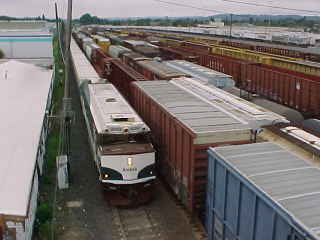

Amtrak Cascades 500 was next.

A while later, a patched former Southern Pacific switcher.

Next, a southbound Union Pacific freight and another northbound.

Southern Pacific 4449 ready to finally move at 9:58 AM.





Southern Pacific 4449 reversing to begin the journey to Cruisin' Sherwood, a custom car show.



Southern Pacific 4449 now moving forward down a yard lead.

Stopped to throw a switch to continue through the yard.

Southern Pacific 4449 at rest before arriving at a signal.

The steam train has now gone under the Holgate Bridge.

Moving slowly south.

Burlington Northern caboose 10330, nee Great Northern X40 built by International Car Company in 1960.

On the rear of the train was Great Northern F7A 274, ex. Pete Replinger 274, exx. Seattle and North Coast 101, exxx. Burlington Northern 610, nee Great Northern 274B built by Electro-Motive Division in 1950.


It was now 10:20 AM and we returned to the car and drove to Lake Oswego, where we found a nice grade crossing among the million dollar homes on North Shore Drive. Our presence there attracted all kinds of attention with people stopping to asking us what was coming. By that time, at 12:05 PM, we had a large crowd waiting for Southern Pacific 4449 and when the engine's whistle was finally heard, the crowd was excited and a few minutes later, Southern Pacific 4449 came into view and there was a smile on every face, both young and old!


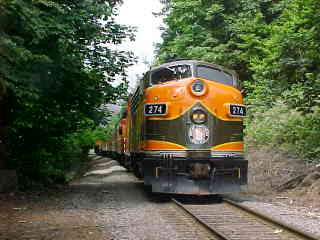
Southern Pacific 4449 and train passed the North Shore Drive grade crossing. Satisfied with our results, we drove to Oaks Park for our next steam train encounter of the day.
Spokane, Portland and Seattle 700 Train RideSpokane Portland & Seattle 4-8-4 700 built by Baldwin in 1938. It was acquired to haul the Inland Empire Express (daytime) and North Bank Limited (overnight) along the north shore of the Columbia River between Spokane and Vancouver. By 1947, the SP&S started purchasing diesels for their premier passenger services. Through the late 1940s and early 1950s, the E-1s continued to pull secondary passenger trains but by 1954, diesels had completely replaced steam for passenger service and the E-1s were relegated to pulling freight trains until 1955. Finally, on 20th May 1956, a spruced-up 700, with its normally grey smokebox painted silver, hauled its last passenger train, the Farewell To Steam with a twenty-one car consist carrying 1,400 passengers from Portland, Oregon to Wishram, Washington and back. After the Farewell to Steam trip, 700, along with other SP&S steam locomotives, were sent to the scrap line.
At the same time, however, the Union Pacific was offering to donate a steam locomotive to the City of Portland and the SP&S also offered 700. It went on static display at Oaks Amusement Park until 1987, then moved to the Brooklyn Rounshouse to continue work to restore it to operating condition. It returned to operation in 1990 and was added to the National Register of Historic Places on 26th January 2006.
We arrived at Oaks Amusement Park parking lot and walked across the street to buy our tickets for the SP&S 700 1:00 PM trip. Chris bought mine, as well as speeder tickets for all four of us at 2:00 PM. Needing a bathroom, I walked into the Amusement Park.
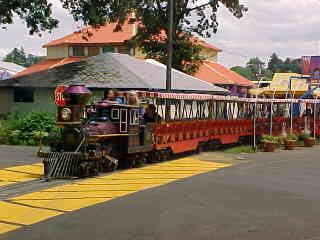
The miniature train that runs through the Amusement Park. I walked over to wait for the return of the noon excursion.

Today's consist was SP&S 4-8-4 700, Pacific Railroad Preservation Association combine 9477, Great Northern Empire Builder coach 1210 "Plum Creek" PPCX 800245 and Samtrak caboose 900. SP&S 700 then reversed into the loading area and the noon passengers detrained before the 1:00 PM passengers boarded. Jim and I chose cupola seats in the caboose.

We started by reversing north.

Running along Oaks Bottom Lake.

Looking north down our route with a bicycle path alongside.

Oaks Bottom Lake.

The steam engine was pushing our train north.

Looking down our route.


About to go under the Ross Island Bridge.

The northern end of our route at SE Taggart Street.

SP&S 700 then started back towards Oaks Park.

Ross Island Bridge was opened in 1926 to accommodate Portland's burgeoning private automobile traffic. It was designed by Gustav Lindenthal of New York City and, like his Queensboro Bridge across the East River in NYC, it is a semi-continuous cantilever structure. There are steel truss anchor arms connected to points on shore, but there is no central suspended span connecting them. Instead those anchor arms support truss panels which project out (cantilever) from piers to the center. While it is not an arch bridge as many may think, it is an aquaduct which many do npt notice. Two 24-inch mains on the bridge convey millions of gallons of water from the Bull Run Reservoir east of town to Portland’s west side.



Rounding a large curve.
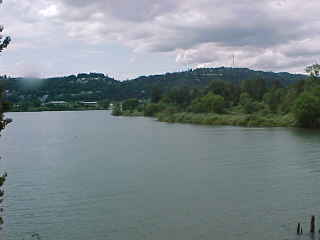
The Willamette River.

Straight running along the bicycle path.

Returning by the speeders and the loading area.

Oaks Amusement Park.

Running to the south end of our route.

Chris Parker in the cupola.

Returning to the loading area, where we detrained.

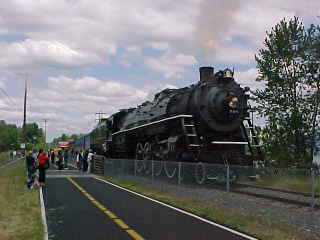

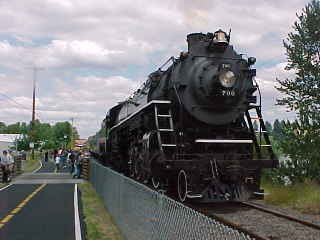
Spokane, Portland and Seattle 4-8-4 700 between trips.
The Speeder Ride
After SP&S 700 departed for its 2:00 PM run, it was time for our speeder ride south with Kevin Novack.
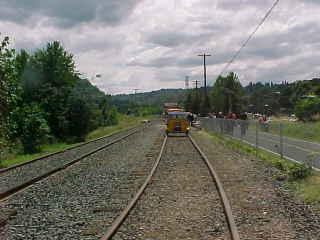
Our trip started with us reversing out of the siding.

Now out on the line, we will pull south after all the others are out of the siding and the switch thrown.

Bob was in the speeder in front of me.
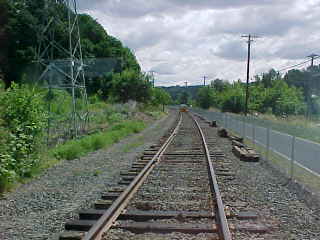
About to enter more new trackage today.

Crossing SE Umatilla Street.

Crossing SE 14th Street.

Nearing the end of our speeder journey.

Kevin Novak's speeder.

At the south end of our route, I was switched to Rob Baur's speeder.

Passing some freight cars.

Running north.

Back to the loading area. I thanked both speeder operators then went to photograph the steam train returning.

SP&S 700 passing the loading area.

The engineer of SP&S 700.

I walked under the tracks for this view of the steam engine.

On the way back to the car, a final parting shot.

After leaving, we drove back to where I saw old streetcar tracks in the street. From there, we drove to Lake Oswego and bought tickets for the 4:00 PM run north on the Willamette Shore Trolley. Chris and I walked over to the Tillamook Restaurant for some food to go and ate it minutes before our trip was to start.
Willamette Shore Trolley HistoryThe Right-of-way of the WST dates back to the 1880's as a narrow-gauge steam railroad linking Portland to Oswego (as Lake Oswego was known back then) and south into the Willamette Valley. The Southern Pacific acquired the line and converted it to standard gauge. In 1914, the line was electrified and Red Electric Interurban service was born. One could board a Red Electric Car and ride to Portland, Beaverton, Hillsboro, Newberg, McMinnville and Corvallis. In 1921, the Elk Rock Tunnel was opened, replacing a wooden trestle that went around Elk Rock. Passenger service ended in 1929, but freight service continued until 1983.
In 1984, the Southern Pacific filed for abandoning the line from Lake Oswego to Portland. A Consortium of local governments and agencies acquired the line to preserve it for future transit use. In 1987, the Willamette Shore Trolley was born. The first car on the line was Blackpool Double-Decker 48, operated by the Oregon Electric Railway Historical Society. Later, a different entity operated other heritage trolleys on the line. The OERHS took over the service again in 1995 with the double-decker and later with a Portland Brill Master Unit streetcar.
The line was extended north to Riverplace at one point but was later cut back to Moody St to permit Portland Streetcar to enter the south waterfront district. The Double-Decker and the Master Unit were retired back to the Trolley Museum in Brooks due to the wear and tear of running the cars on the WST. The streetcar operated today is a modern-built Vintage Trolley. Vintage Trolley 514 was used on the Portland MAX line and Portland Streetcar as a tourist draw. The car is one of four cars built in 1991 for this service. Although popular with the tourists, the frequency of MAX and Portland Streetcar left little time slots for the VT cars to operate. St. Louis leases VT 511 and 512 for a new streetcar line and VT 513 and VT5 14 are now residents of the WST.
Our Ride
We all boarded Oregon Electric Railway Historical Society streetcar 813, ex. Portland Traction 4012 1950-1959, exx. Portland Traction 813 1944-1950, nee Portland Electric Power 813 1932-1944 built by J.G. Brill in 1932. I had ridden this line in 2003 but for my three friends, it would be their first trip. We passed the car house before passing through a dark and cool tunnel and I was in relax mode.


The curved trestle on the line.

Jim and Chris at the now shorter end of the route.


Streetcar 813 reached the north end of the line, where we detrained for pictures then reboarded and had a relaxing trip back to Lake Oswego.
Southern Pacific 4449 at Sherwood
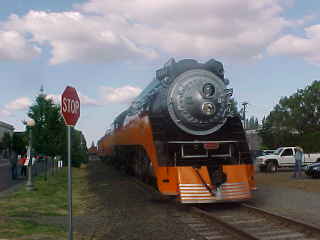
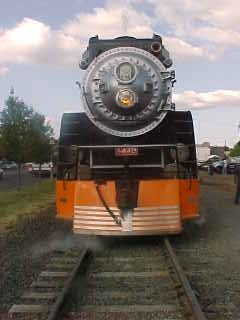
After the trolley ride, we drove out to Sherwood to see Southern Pacific 4449 and while the activities were over before we arrived, we had no problems finding the steam engine and I then went into the cab.

The Southern Pacific Sunset symbol on the wooden floor of Southern Pacific 4449.

The engineer's controls.

The fireman's controls.

The middle view.

The author in the engineer's seat.

One last photograph of Southern Pacific 4449 at Sherwood.

The builder's plate. We then went to Shari's Restaurant for dinner and afterwards, Chris realized that he had left his jacket back with SP&S 700. Jim, Chris and Bob went into a Baskin Robbin's for ice cream while I planned a route back to Oaks Park, which did not take very long.



Spokane, Portland and Seattle 700 in the evening light. I found Chris' jacket at the boarding area's lost and found then we all returned to the Days Inn for our last night in Portland. Cal State Fullerton beat Missouri 9-1 to advance to the College World Series and I wrote today's story before calling it a night.
| RETURN TO THE MAIN PAGE |